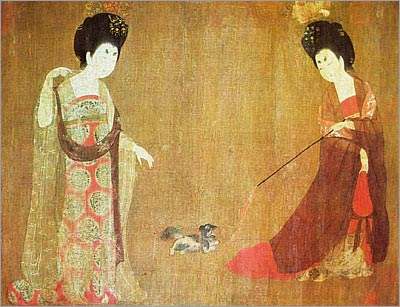STYLE IN THE EAST
200BCE - 600CE
China was known as Ceres (from the word for silk) in the ancient world after its legendary and luxurious silks that were traded to the West along the Silk Road.
The rich stashes of garments and accessories found in ancient tombs show how sophisticated the textiles and clothing were.
They included highly patterned, light - reflective fabrics, and translucent gauze weaves.
By layering garments of different lengths, and adding contrasting linings, waist sashes, and bands around the neck, strikingly colorful combinations were achieved.
Elaborate cloth turbans and wide sleeves were to influence fashion in the West.
The T-shaped kimono-style garments from China and Japan had wide sleeves that hung from the elbow over the wrist and different proportions than Western-style tunics.
In central Asian and Persian areas (modern Iran and Iraq) clothing was more fitted, tight to the wrists and with shaped skirts, influenced by the nomadic, horse-riding peoples.
Silk Road
The Silk Road was not one but several trading routes through the mountains and deserts between Asia, the Arabian peninsula, and the Mediterranean.
Silk was a prime commodity, along with precious stones and spices.
Excavations along the Silk Road offer glimpses into the cloths being traded.
For example, at Palmyra in Syria-a major trading center that handled goods from China.
India, and Iran in the Roman period - Chinese silks have been found in tombs.
After Western cultures fell for silk's allure, their goal was to learn the secrets of sericulture (obtaining silk from silkworms) for themselves.
The Persians succeeded by the 3rd century CE.
东方风格
公元前200年 - 公元600年
当传奇与奢侈的丝绸经丝绸之路到达西方之后,古代世界称中国为大地女神Cere克瑞斯。
在被发现的古代墓葬中,蕴藏着丰富的服装与配饰,它们展示了当时纺织品与服饰有多么复杂。
其中包括高水平的图案装饰,光反射面料,以及半透明纱织物。
通过不同长度的分层服装,加上收紧的衬里,腰带,以及颈部装饰带,完成了一套色彩丰富引人注目的组合。
精心制作的布头巾与宽袖笼都影响了西方的时尚观。
来自中国与日本的T形和服式服装,拥有和西式长袍不同的,自手肘到腕部的大宽袖。
在亚洲中部与波斯地区(现代的伊朗与伊拉克),服饰裁剪更为合身,他们喜欢在手腕部收紧,也喜欢造型感的裙子,这是收到当时游牧民族的影响。
丝绸之路
丝绸之路不仅仅是一条,而是多条介于亚洲,阿拉伯半岛与地中海山脉与沙漠之间的贸易路线。
丝绸是当时主要的商品,除此之外还有宝石与香料。
沿着对丝绸之路的挖掘,我们可以看到当时正在进行贸易的布料。
例如,叙利亚的巴尔米拉就是一个接收中国商品的主要贸易中心。
罗马时期的印度与伊朗,他们的棺木中就有中国的丝绸。
当西方文化对丝绸一见倾心之后,他们就立志学习蚕丝业的秘密(如何从蚕茧中获得丝)。
而波斯人在公元前世纪获得成功。



